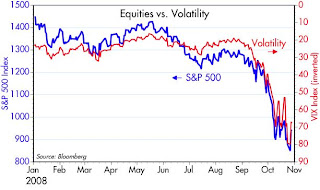 This chart suggests that one of the biggest reasons for the market's collapse is fear. The red line (VIX) is a measure of the implied volatility of equity options, which in turn is highly correlated to the market's fears, doubts, and uncertainties. The higher the fear factor (which shows up as a declining red line since I have inverted the scale), the more people are willing to pay for the protection of things like put options, and the higher the VIX. Fear also contributes to a lack of liquidity and that too can depress prices.
This chart suggests that one of the biggest reasons for the market's collapse is fear. The red line (VIX) is a measure of the implied volatility of equity options, which in turn is highly correlated to the market's fears, doubts, and uncertainties. The higher the fear factor (which shows up as a declining red line since I have inverted the scale), the more people are willing to pay for the protection of things like put options, and the higher the VIX. Fear also contributes to a lack of liquidity and that too can depress prices.This chart is quite similar to the one comparing swap spreads to equities in my post last night. The main difference is that swap spreads are typically a leading indicator, whereas the VIX is a coincident indicator.
If fear and uncertainty subside, there is a lot of room for equity prices to move higher. Fear is easier to vanquish than depression. We're not talking depression by any stretch of the imagination.





4 comments:
Thanks for your blog Scott!
I agree that we are not facing a depression but are currently in the grips of fear. I have seen recent poll results on CNN that indicate 40-50% (I don't recall the exact figure) of Americans think we're headed into a depression.
It seems the proximate cause of this extreme fear was the media coverage of the debate over the TARP plan, generally called the "Wall Street Bailout" by the media. Perhaps a new president can help rebuild confidence. However, I worry about a new bubble of fear among the job creators/employers if that new president happens to be Obama and his inner socialist side slips out again. I wonder how much of this fear is shared by others and already discounted by the market?
Mark
Scott,
To continue the line of thought began by Mark.....
Now that we have seen how the stock market, the general economy and the Treasury/Fed has reacted to the passage of the bailout, does it seem to you that Bernanke and Paulson both misdiagnosed the problem confronting them and also chose the wrong remedy?
It seems that Bernanke studied the Great Depression quite closely. But prior to this financial crisis, did any economist with a significant reputation, including Bernanke, suggest that the way to avoid a Great Depression was to give 700 billion dollars to financial institutions (and perhaps, if I read the news correctly, insurance companies and automobile makers) that were unable to manage their risk effectively?
It seems that Bernanke and Paulson chose a "fly by the seat your pants" approach and increased government's role in the economy. The impact of their approach so far seems to be, given the stock market's reaction since passage of the bailout legislation, either neutral or negative.
It's hard for me to believe that if the Federal Reserve had simply dumped a huge amount of liquidity into the system (which they have done and the 1929-1930 Fed did not do), the market might have performed better than it has.
Do you agree? What is to explain the seemingly erratic behavior of normally sober guys like Bernanke and Paulson? I'm confused.
I found an interesting analysis of stock market earnings and valuation at: http://www.crestmontresearch.com/pdfs/Stock%20PE%20Report.pdf
Here's the bottom line for why stock prices never reached the heights predicted by capitalized proftis (ie. interest rates): those earnings were discounted because we were at a cyclical earnings peak in recent years.
The S&P 500 equilibrium earnings level corresponding to our current GDP is 60. Of course, trough earnings during a recession are likely to go below this level. Applying a reasonable P/E of 15 to the equilibrium earnings results in the S&P at 900.
This actually makes sense to me on an instinctive level. Not only did our credit bubble (ie. excessive leverage) boost domestic earnings above their historic trend relative to GDP, but our trade deficit exported excess liquidity to the world, which the world used as reserves to lever up their economies.
By the way, I don't know proper blog etiquette, so I wasn't sure if this comment should be posted on the latest blog entry, or back on the more relevent entry on stock valuations.
Mark: There are two ways to view our trade deficit. Pessimists say that we bought too much from the rest of the world, leaving ourselves with a mountain of debt. You add that the rest of the world squandered the money we sent them. Optimists say that the rest of the world didn't buy enough goods and services from us, and instead decided to invest the money in our markets. Whether that money was squandered is a question we can't answer at this point. But in the end, we bought a lot of cheap goods and services from the rest of the world, and it's hard to see how that is a bad thing.
Post a Comment